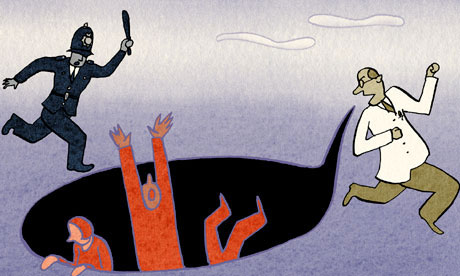'People will forgive you for being wrong, but they will never forgive you for being right - especially if events prove you right while proving them wrong.' Thomas Sowell
Search This Blog
Monday, 12 February 2024
Wednesday, 19 July 2023
A Level Economics 28: The Law of Diminishing Returns and Output in the Long Run
Fixed Costs:Fixed costs are expenses that do not change with the level of production or sales. They remain constant regardless of the quantity produced.
Examples of fixed costs include rent, property taxes, insurance premiums, and salaries of permanent employees.
These costs are incurred even if a company produces nothing or temporarily shuts down its operations.
Fixed costs are typically represented as a lump sum or a fixed amount.
Variable Costs:Variable costs are expenses that vary with the level of production or sales. They change proportionally as the quantity produced or sold changes.
Examples of variable costs include raw materials, direct labor, packaging costs, and sales commissions.
Variable costs increase as production or sales increase and decrease as production or sales decrease.
Variable costs are generally represented on a per-unit basis or as a variable cost per production level.
Short Run vs. Long Run:
Short Run:The short run refers to a period of time in which at least one input is fixed, usually the plant size or capital.
In the short run, a firm can only adjust its variable inputs, such as labor or raw materials, to respond to changes in production or demand.
For example, if a bakery experiences an increase in demand for its bread, it can hire more bakers (variable input) but cannot immediately expand its production facility (fixed input).
In the short run, a firm's ability to adjust production is limited by fixed inputs, leading to a less flexible response to changes in market conditions.
Long Run:
The long run refers to a period of time in which all inputs are variable, and there are no fixed inputs.
In the long run, a firm can adjust all its inputs, including plant size, capital equipment, labor, and raw materials.
----
The law of diminishing returns (happens in the short run only) states that as more units of a variable input, such as labor, are added to a fixed input, like land or capital, the marginal product of the variable input will eventually decrease. In simpler terms, it means that adding more of a specific input will lead to smaller increases in output.
For example, let's consider a bakery with a fixed-size oven. Initially, with one baker, the bakery produces 100 loaves of bread per day. When a second baker is added, the production increases to 180 loaves per day, reflecting a substantial increase due to division of labor and coordination. However, as more bakers are added, the production gains become smaller.
With a third baker, the production may increase to 220 loaves per day, and with a fourth baker, it may increase to 240 loaves per day. The additional output gained from each additional baker decreases, indicating diminishing returns. For instance, adding the fifth baker may only result in a small increase to 245 loaves per day.
The law of diminishing returns occurs because the fixed input, such as the oven, becomes a limiting factor. As more bakers are added, they start competing for oven space and other resources, leading to less efficient use of the fixed input. The bakery may reach a point where adding more bakers becomes counterproductive, as the additional workers may create congestion or coordination issues, resulting in lower productivity.
Understanding the law of diminishing returns is essential for businesses to make informed decisions about resource allocation. It helps determine the optimal level of inputs to achieve maximum productivity and avoid inefficient use of resources. By identifying the point of diminishing returns, businesses can optimize their production processes and ensure efficient resource utilization for better cost-effectiveness and output levels.
In the long run, the output can be adjusted and optimized based on the flexibility of all inputs. The ability to modify all inputs allows firms to fully adapt their production processes and take advantage of economies and diseconomies of scale. Here's what typically happens to output in the long run:
Economies of Scale: Economies of scale refer to cost advantages obtained by increasing the scale of production. As firms expand their output and production levels, they can benefit from economies of scale, which can lead to increased output and lower average costs per unit.
Economies of scale can arise from various factors such as increased specialization, bulk purchasing discounts, improved division of labor, efficient use of resources, and improved utilization of production facilities.
With economies of scale, firms can produce more output at a lower average cost per unit. This can result in increased profitability and competitiveness.
Expansion of Output: In the long run, firms can expand their output by adjusting all inputs and taking advantage of economies of scale. They can invest in additional capital, hire more labor, and increase the use of other resources to meet the higher demand and optimize their production processes.
With increased scale of production, firms can achieve higher levels of output while potentially reducing their average costs. This allows them to meet market demand, increase market share, and potentially generate higher profits.
Diseconomies of Scale: While economies of scale can bring cost advantages, there is a point beyond which further expansion can lead to diseconomies of scale. Diseconomies of scale occur when the cost per unit increases as output increases.
Examples of diseconomies of scale include increased coordination and communication challenges, diminishing managerial control, bottlenecks in production processes, and increased bureaucracy.
When a firm faces diseconomies of scale, its average costs per unit of output start to rise, potentially impacting profitability. This can result from inefficiencies or challenges in managing larger operations.
Optimization of Production: In the long run, firms have the opportunity to optimize their production processes and achieve higher levels of efficiency. They can analyze and adjust the combination of inputs, technologies, and organizational structures to maximize output while minimizing costs.
By optimizing production processes, firms can take advantage of economies of scale and avoid or mitigate diseconomies of scale. This involves streamlining operations, eliminating bottlenecks, improving coordination, and adopting efficient production techniques.
Optimization allows firms to achieve the optimal scale of production that maximizes output while maintaining cost efficiency.
In summary, in the long run, firms can adjust their inputs, expand or contract their operations, optimize production processes, and benefit from economies of scale. This enables them to achieve higher levels of output, improve efficiency, and respond effectively to changes in market conditions and demand while avoiding or managing potential diseconomies of scale.
Friday, 23 June 2023
Economics Explained: Assumptions and Economic Models
An assumption, in the context of economic models, refers to a simplifying belief or proposition about the behaviour of individuals, firms, or the overall economic system. These assumptions are necessary because economic models attempt to capture the complexity of real-world phenomena and make them more understandable and analysable.
Assumptions serve as building blocks for economic models, providing a foundation upon which the analysis can be conducted. They help economists create a framework that abstracts away unnecessary details and focuses on key variables and relationships of interest. By making assumptions, economists can isolate specific factors and explore their impact on economic outcomes.
For example, when constructing a model to analyse consumer behaviour, economists may assume that individuals are rational decision-makers who seek to maximise their personal satisfaction or utility. While this assumption may not accurately capture every aspect of real-world consumer behaviour, it simplifies the decision-making process and allows economists to predict how individuals might respond to changes in prices, incomes, or other factors.
Similarly, in the study of market dynamics, economists often assume perfect competition, which assumes a large number of buyers and sellers, identical products, and perfect information. Although perfect competition is rarely found in reality, this assumption enables economists to study market equilibrium, price determination, and the effects of various policy interventions in a more manageable way.
Assumptions in economic models also often employ the ceteris paribus principle, which means "all else equal." This principle assumes that while analysing the relationship between two variables, all other factors remain constant. This allows economists to focus on the specific relationship of interest without getting entangled in the complexities of simultaneous changes in multiple factors.
It is important to note that assumptions are simplifications and abstractions, and they may not always perfectly reflect reality. However, they serve a crucial role in economic modelling by making the analysis feasible, highlighting key relationships, and providing initial insights into economic behaviour and outcomes. While assumptions are necessary, it is also important for economists to continuously test and refine them based on empirical evidence to improve the accuracy and reliability of economic models.
Assumptions and simplifications in mathematical economic models can introduce potential biases and limitations in several ways:
Inaccurate representation of reality: Economic models are abstractions that aim to simplify the complex real world. However, by making assumptions and simplifications, models may fail to capture the full complexity and nuances of economic phenomena. These simplifications can lead to a mismatch between the model's assumptions and the actual behaviour of individuals, firms, or markets, potentially introducing biases in the model's predictions.
Omission of relevant variables: Economic models often involve simplifications that exclude certain variables or factors that may be important in real-world situations. This exclusion can limit the model's ability to provide a comprehensive understanding of the economic system under study. The omission of relevant variables can result in biased or incomplete analysis, as important drivers of economic behaviour or outcomes may be neglected.
Assumptions about individual behaviour: Many economic models rely on assumptions about the behaviour of individuals, such as the assumption of rationality or self-interest. However, these assumptions may not always hold true in reality. Individuals may exhibit bounded rationality, have imperfect information, or behave altruistically, which can deviate from the assumptions made in economic models. Such deviations can lead to biased predictions or inaccurate representations of real-world phenomena.
Simplified market structures: Economic models often assume simplified market structures, such as perfect competition, monopoly, or oligopoly. While these assumptions provide a useful framework for analysis, they may not reflect the complexities of actual markets. Real-world markets can exhibit various degrees of competition, market power, and imperfect information, which can introduce biases when using simplified market structures in economic models.
Linear relationships: Many economic models assume linear relationships between variables for simplicity and tractability. However, in reality, relationships between variables may be nonlinear or exhibit diminishing returns. Assuming linearity can introduce biases in predictions or policy recommendations, as it may not accurately capture the actual dynamics and interactions among variables.
Limited scope of analysis: Economic models often focus on specific aspects or sectors of the economy, neglecting interdependencies and feedback effects. This limited scope can introduce biases by overlooking broader systemic effects or failing to capture the full consequences of policy interventions. It is important to recognise that economic systems are complex and interconnected, and simplifications in models can restrict the understanding of these interconnections.
To mitigate these limitations and biases, economists employ various techniques, such as sensitivity analysis, robustness checks, and empirical validation, to test the assumptions and evaluate the robustness of model predictions. Additionally, economists strive to develop more realistic and nuanced models by incorporating more accurate assumptions, relaxing unrealistic assumptions, or adopting alternative modelling approaches to address the limitations and biases introduced by simplifications.
Thursday, 13 October 2016
Don’t call for another referendum – they cause more problems than they solve
Many journalists ply their trade because it is politics by other means. I joined this profession for several reasons, including the need to make a living and the absence of suitable alternatives. But one of the main reasons was that I believe very strongly in democracy – a political idea – because it is a way of diffusing power so that it is not just concentrated among the rich and the few.
As a democrat, even a radical democrat, for years I harboured an instinctive fondness for referendums. Give the people a say. Let them decide. All that stuff. But judging by the experience of Britain's most recent referendum, I have changed my mind. I now think fewer would be preferable.
This is not necessarily because I think the wrong result transpired. Rather it is because I can see the problems with referendums more clearly now. I reckon there are at least four.
First, they too often turn on variables unrelated to the question at hand, such as whether a particular leader is popular that month. Colombia's rejection of a peace deal may have turned on the weather.
Third, they reduce very complex issues to binary decisions, ignoring the fact that politics is full of trade-offs; leaving the European Union, for instance, can mean many different things.
Here's just such a trade-off: you can lower immigration levels, but you'll be poorer in the short-term as you probably have to leave the single market. It's what people voted for – even if they didn't realise it. But now there's a huge move in parliament to pretend this trade-off didn't happen. You see it in the intellectually docile terminology of hard versus soft Brexit, as if there were only two options from the infinite variety of potential end results to the coming negotiation.
And that is the fourth problem with referendums: the losers often have nowhere to go. You end up with a hugely disenfranchised constituency, who are either agitating for another go or nurse such a constant grievance that they undermine the whole electoral system. That is what is happening now.
It is right and proper that parliament should scrutinise the negotiation undertaken by Theresa May and her team, but what cannot happen is a re-run of the EU referendum. The result is in – and it is clear. Yet the attempt to cobble together a parliamentary coalition against leaving the single market is a giant festival of sour grapes masquerading as patriotism and belief in democracy.
The shenanigans this week illustrate exquisitely how, far from encouraging participation and supporting democracy, referendums generally end up subverting it.
Brexit – that dreaded, bizarre word, simultaneously so empty and so full – has come to define this government though nobody knows what it means and nobody has a clue how to deliver it. Under the guise of fortifying our democracy, it has started to consume it. That's not what plebiscites are meant to do.
Friday, 1 February 2013
Are Footballers cleverer than PhD students? Think again

Saturday, 27 October 2012
Wave a banknote at a pundit and he'll predict anything

